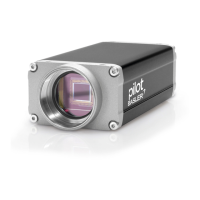Image Acquisition Control
98 Basler pilot
8.7 Exposure Active Signal
The camera’s “exposure active” (ExpAc) signal goes high when the exposure time for each image
acquisition begins and goes low when the exposure time ends as shown in Figure 37. This signal
can be used as a flash trigger and is also useful when you are operating a system where either the
camera or the object being imaged is movable. For example, assume that the camera is mounted
on an arm mechanism and that the mechanism can move the camera to view different portions of
a product assembly. Typically, you do not want the camera to move during exposure. In this case,
you can monitor the ExpAc signal to know when exposure is taking place and thus know when to
avoid moving the camera.
Fig. 37: Exposure Active Signal
By default, the ExpAc signal is assigned to physical output line 1 on the camera. However, the
assignment of the ExpAc signal to a physical output line can be changed.
For more information about changing the assignment of camera output signals to physical output
lines, see Section 10.2.1 on page 139.
For more information about the electrical characteristics of the camera’s output lines, see
Section 7.7.2 on page 73.
Note
When you use the exposure active signal, be aware that there is a delay in the
rise and the fall of the signal in relation to the start and the end of exposure.
See Figure 37 for details.

